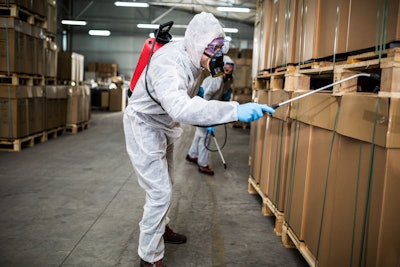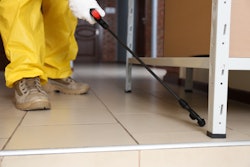
With major backups affecting supply chains globally, warehousing facilities are experiencing a slew of issues including significant shipping delays, product being stored for much longer than intended, and even changes to shipping routes. While all of these issues impact the shipping timeline and getting products to your customers, they also have an impact on pest management at your facility. With products coming from different regions around the world, each facility may need to train their employees to look for and identify pests they are not used to. Training employees to incorporate pest control practices into their daily duties can help make it easier to proactively manage pest pressures before they become a problem within your facility.
What to look for
When your team is already under pressure to keep the lines moving, it’s imperative that they continue to properly inspect inventory as it is loaded and unloaded off trucks and shipping containers. This helps ensure that products are in good condition and pests are kept out of your facility. If your team is unloading new products and sees something unfamiliar and is unsure of what to do, the first step is simple: if you see something, say something. Empower your team to speak up and report issues by having a process in place for reporting. Although this may be a simple reminder, it is a necessary one for employees, especially those handling shipments. If you’re not sure whether pests have already entered your facility, look for these subtle indicators of pest problems:
- Spiders and webbing. Check for webs in racks and shipment boxes. Since spiders feed on other pests, the location of spider webs may be an indication of what type of pest is present. If spider webs are in the rafters, there may be flying insects, and if the webs are on the floor, be on the lookout for crawling insects.
- Feces: Check for droppings in shipments, around the facility and along the walls as this could indicate a rodent issue.
- Dampness: Moisture exposure can help accelerate pest activity, so look for water stains on packaging and pallets.
- Mold/fungus growth: If a wood pallet has discoloration from fungal growth, it is a possible food source for fungus feeders, a group of common pests that are an issue for warehouse facilities.
- Shavings of cardboard or wood sawdust. If a rodent decided to hitch a ride in, they may have created an opening in a shipment box. Even if a hole is not visible, there may be shavings left behind when the pallet is moved.
While your pest control provider will conduct site visits on a regular basis, it can be challenging to catch pest issues in between service visits. That’s why it’s important to involve and train your staff on your pest prevention plan. Ask your pest control provider to help you in this effort. Not only can you ask to accompany them on a service to learn from their inspection, but they should also be able to provide trainings for your staff on pest hotspots and prevention techniques.
Reminding your staff about the health and safety risk pests pose can give them a deeper understanding of why pest prevention is important and get their commitment. Equipping your staff with pest-sighting protocols and designated areas of responsibility can boost confidence in your team to help get the job done.
Suggested inspection protocols
With product shipments arriving from different regions and being rushed into warehouse storage or into a new shipment, establishing proper inspection protocols can help your staff be prepared for a potential pest exposure:
- Have someone observe trucks while they’re open and unloading to watch for any stowaway pests.
- When unloading pallets or product, set the product aside from other inventory to be inspected for any signs of pest activity before placing with the rest of the stock.
- Always be on the lookout for damaged product, or any holes or openings not made by a knife or forklift blade. These holes could be a sign of gnawing rodents, cockroaches or some other kind of pest.
- Inspect the packing tape on shipment boxes to check for insects such as weevils, beetles or moths stuck to the tape that may have been trying to get in or out of the product.
- If there is pest activity in the truck, make the decision whether or not to accept the shipment or quarantine the shipment immediately. Your pest control provider can talk to you about what that quarantining should look like, and where it should be located.
Preventive measures
As goods from all over the world enter your facility, so can both familiar and new pests looking for a new home. To cut down on the chances of these pests finding a new home in your facility, remind your staff to:
- Close dock doors between shipments and deliveries.
- Ensure cracks and crevices are filled to keep pests out.
- Stay on top of incoming shipment schedules to manage and utilize proper storage protocols.
- Break down any excess boxes away from the product storage area to prevent exposing potential pests to other areas of your facility.
- Store products off warehouse floors and spaced out on shelves away from the walls to reduce hiding places for pests.
- Maintain a detailed record of any pest observations to be reported to your pest control provider for prompt treatment.
- Keep lines of communication open between staff, management and your pest control provider to ensure any problems are addressed as soon as possible and everyone is on the same page.
The past two years has involved many changes to our daily lives and operations. With global supply chain issues continuing to linger this year, it is more important than ever for warehouses to educate employees on spotting the signs of a pest issue and ensure the tools are in place to encourage them to have a proactive role in pest prevention.


















